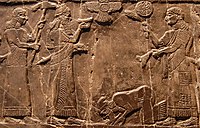2 Kings 9
| 2 Kings 9 | |
|---|---|
 The pages containing the Books of Kings (1 & 2 Kings) Leningrad Codex (1008 CE). | |
| Book | Second Book of Kings |
| Hebrew Bible part | Nevi'im |
| Order in the Hebrew part | 4 |
| Category | Former Prophets |
| Christian Bible part | Old Testament |
| Order in the Christian part | 12 |
2 Kings 9 is the ninth chapter of the second part of the Books of Kings in the Hebrew Bible or the Second Book of Kings in the Old Testament of the Christian Bible.[1][2] The book is a compilation of various annals recording the acts of the kings of Israel and Judah by a Deuteronomic compiler in the seventh century BCE, with a supplement added in the sixth century BCE.[3] This chapter records Jehu's anointing as the next king of Israel and his assassinations of Jehoram the king of Israel, Ahaziah the king of Judah and Jezebel the queen mother of Israel.[4] The narrative is a part of a major section 2 Kings 9:1–15:12 covering the period of Jehu's dynasty.[5]
Text[]
This chapter was originally written in the Hebrew language and since the 16th century is divided into 37 verses.
Textual witnesses[]
Some early manuscripts containing the text of this chapter in Hebrew are of the Masoretic Text tradition, which includes the Codex Cairensis (895), Aleppo Codex (10th century), and Codex Leningradensis (1008).[6] Fragments containing parts of this chapter in Hebrew were found among the Dead Sea Scrolls, that is, 6Q4 (6QpapKgs; 150–75 BCE) with extant verses 1–2.[7][8][9][10]
There is also a translation into Koine Greek known as the Septuagint, made in the last few centuries BCE. Extant ancient manuscripts of the Septuagint version include Codex Vaticanus (B; B; 4th century) and Codex Alexandrinus (A; A; 5th century).[11][a]
Locations[]
This chapter mentions or alludes to the following places (in order of appearance):
- Ramoth-Gilead
- Jezreel
- Megiddo
- Jerusalem
Analysis[]
This chapter and the next one contain one continuous narrative of Jehu's overthrow of the Omride dynasty and destruction of the Baal worship in Israel, reopening the battle against apostasy which was started by Elijah (1 Kings 18).[13] Fulfilling the divine commission given to Elijah, Elisha arranged the anointing of Jehu who then executed a total revolution in Israel and Judah, by killing the reigning kings (and their family members) of both kingdoms. The narrative may be divided into two parallel sections, the first one about the assassination of the leaders (including Jezebel, the queen mother of Israel) in chapter 9 and the second about the killing of their kinsmen (including the Baal worshippers as Jezebel's "kin"), ending with a summary of Jehu's reign and the consequences of his action in relation to his faithfulness to YHWH in chapter 10.[14] The structure can be as follows:[b]
- A Jehu is anointed king (9:1-15)
- B Jehu kills King Jehoram outside Jezreel (9:16-26)
- C Jehu kills King Ahaziah in Beth-haggan (9:27-29)
- D Jehu has Jezebel killed in Jezreel (9:30-37)
- B' Jehu massacres the house of Ahab in Jezreel (10:1-11)
- C' Jehu massacres the kinsmen of King Ahaziah at Beth-eked (10:12-14)
- D' Jehu massacres worshipers of Baal and destroys house of Baal in Samaria (10:15-28)
- A' Summary of reign of Jehu (10:29-36)
The anointing of Jehu (9:1–15)[]


